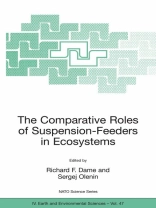Animals are a major link between the water column (pelagic) and the bottom (benthic) habitats in most shallow systems. This coupling is dominated by active processes such as suspension-feeding in which the organism actively uses energy to pump water that is then filtered to remove suspended particles that are consumed while undigested remains are deposited on the bottom. As a result of this feeding on and metabolism of particles, the animals excrete dissolved inorganic and organic waste back into the water column, and thus, become major components in the cycling and feedback of essential elements. With relatively high weight specific filtration rates of 1— 10 liters/hour/gram dry tissue and a propensity to form large aggregated populations (beds, reefs, schools and swarms), these organisms can play an important role in regulating water column processes
Although estuarine bivalve molluscs such as oysters and mussels dominate the suspension-feeder literature, other groups including plankton and nekton that are found in estuarine as well as other aquatic systems are also potentially important removers of suspended particles. Thus, a significant part of the NATO Advanced Research Workshop focused on suspension-feeders as controllers of plankton abundance, biomass and diversity, system metabolism, nutrient cycling and scale dependency.
Systems dominated by suspension-feeders are typically impacted by human activities including recreation, aquaculture, human and industrial pollution, and bilge water from shipping. Suspension-feeders are often impacted by fisheries and over-exploitation. These impacts commonly result in changes in ecosystem structure either through the food chain concentration of harmful substances or diseases, the introduction of alien species of suspension-feeders, or the instability of suspension-feeders systems through species displacement or phase shifts in the dominance between different suspension-feeding components such asnekton or zooplankton. These issues were addressed near the close of the workshop along with conclusions and syntheses developed by the working groups.
Зміст
Modelling Particle Selection Efficiency of Bivalve Suspension Feeders.- Field Measurements on the Variability in Biodeposition and Estimates of Grazing Pressure of Suspension-Feeding Bivalves in the Northern Baltic Sea.- Can Bivalve Suspension-Feeders Affect Pelagic Food Web Structure?.- Motile Suspension-Feeders in Estuarine and Marine Ecosystems.- Impact of Suspension-Feeding Nekton in Freshwater Ecosystems: Patterns and Mechanisms.- Influence of Eastern Oysters on Nitrogen and Phosphorus Regeneration in Chesapeake Bay, USA.- How does Estimation of Environmental Carrying Capacity for Bivalve Culture Depend upon Spatial and Temporal Scales?.- Impact of Increased Mineral Particle Concentration on the Behavior, Suspension-Feeding and Reproduction of Acartia clausi (Copepoda).- Suspension-Feeders as Factors Influencing Water Quality in Aquatic Ecosystems.- Neoplasia in Estuarine Bivalves: Effect of Feeding Behaviour and Pollution in the Gulf of Gdansk (Baltic Sea, Poland).- Bivalves as Biofilters and Valuable Byproducts in Land-Based Aquaculture Systems.- Significance of Suspension-Feeder Systems on Different Spatial Scales.- Invaders in Suspension-Feeder Systems: Variations along the Regional Environmental Gradient and Similarities between Large Basins.- Contrasting Distribution and Impacts of Two Freshwater Exotic Suspension Feeders, Dreissena polymorpha and Corbicula fluminea.- Functional Changes in Benthic Freshwater Communities after Dreissena polymorpha (Pallas) Invasion and Consequences for Filtration.- Does the Introduction of the Pacific Oyster Crassostrea gigas Lead to Species Shifts in the Wadden Sea?.- One Estuary, One Invasion, Two Responses: Phytoplankton and Benthic Community Dynamics Determine the Effect of an Estuarine Invasive Suspension-Feeder.- Development of Human Impact on Suspension-Feeding Bivalves in Coastal Soft-Bottom Ecosystems.- Oyster Reefs as Complex Ecological Systems.- The Roles of Suspension-Feeders in Ecosystems: Synthesis and Conclusions.












